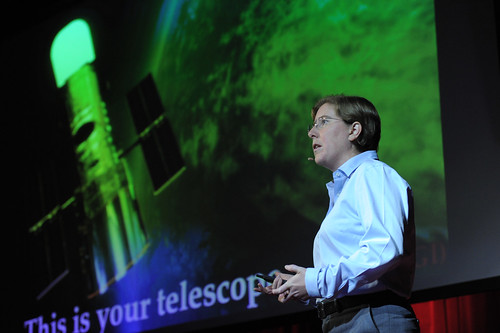The honor of kicking off the evening of TED Full Spectrum auditions fell to Jane Rigby, an astrophysicist at the NASA Goddard Space Flight Center and deputy project scientist for operations for the James Webb Space Telescope (the planned successor to the Hubble Space Telescope). Together with fellow NASA astrophysicist Amber Straughn, she put together a slide-blizzard — a rapid-fire series of images — to illustrate the extraordinary beauty and scientific power produced by space telescopes.
We caught up with her after the talks to ask about the audition experience.
How did the night feel for you?
It was really fun. I thought all the talks were interesting. Some of them I need to go think about. I think they were really profound, so I had a blast.
How did you put your audition video together?
I saw the call, and thought that would be something different. We’ve been thinking about how to reach different audiences, how to break out of what we’re doing and experiment with social media and different ways of connecting with people.
We through it together on a Friday, before the deadline, in a couple hours. Some of the artists here have amazing skills at editing things, and making these beautiful videos, and we did a Keynote presentation, that’s our technical skill.
We thought it was a long shot, but we also thought it was a compelling story. Humans made space telescopes and we wanted to talk about that.
Have you done a lot of outreach and public speaking about the James Webb Space Telescope before?
I just joined Goddard in September, but I do a lot of public speaking. I think there’s a duty for a scientist who takes public money — astronomical research is funded by tax dollars — there’s a duty to talk about what we’re doing, what we’re discovering, what we’re learning, and to talk about that in a really personal way. That’s a very serious part of what we do. It’s not an afterthought, it’s core to what we do. If we don’t explain what we’re doing, and if the public doesn’t think it’s important, then we’ll stop doing it.
So, I do a lot of public talks, but this was a little unusual. I was not used to the loud rap music before hand — it was awesome.
In your talk, you said anybody can send in a proposal to use the Hubble Space Telescope?
Last year there were proposals from 40 countries, and 43 states, so almost the whole USA and a lot of the world. There were observations last year of Hanny’s Voorwerp ‑ Voorwerp means ‘object’ in Dutch’. It is a strange object that was discovered by a high school teacher in the Netherlands though a project called Galaxy Zoo. She posted in Dutch, “I have discovered a weird object.” So, Hanny’s Voorwerp is this really weird thing that’s happening in a galaxy, and Hubble observed it last year. So, that’s an observation that was inspired by amateur astronomers. That’s not the only one. There was an eruption in the Orion Nebula that was discovered by amateurs.
So, anyone can apply, and I think that’s very noble. NASA and Europe built Hubble, but we don’t want to restrict it to scientists in those countries. We want everybody who has ideas.
What’s your favorite Hubble image?
My favorite is one we took on March 1st. It’s not public yet. We’re going to do a press release this summer. It’s of a lensed galaxy that I’ve been studying. A galaxy that’s been gravitationally lesned by the mass of a cluster of galaxies. This galaxy appears seventeen times brighter than it normally would be, and stretched across the sky seventeen times more than it would be. It is crazy bright and huge, and we’re using it to study what galaxies were like seven billion years in the past.

Comments